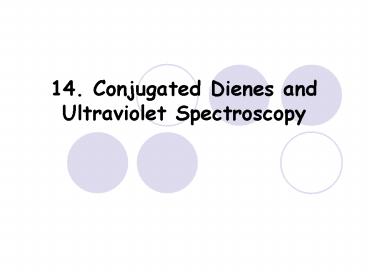14' Conjugated Dienes and Ultraviolet Spectroscopy PowerPoint PPT Presentation
1 / 22
Title: 14' Conjugated Dienes and Ultraviolet Spectroscopy
1
14. Conjugated Dienes and Ultraviolet Spectroscopy
2
Topics to discuss
- Conjugated Dienes
- What are they?
- Electrophilic addition reactions
- Allylic carbocations and their stability
- Diels-Alder Cycloadditions
- Dienes and dienophiles
- Required physical properties
- UV Spectroscopy
- What is it and why is it useful?
- Effect of conjugation
3
Conjugated and Non-conjugated Dienes
- Q What is a conjugated diene?
4
Polyenes
- Q What is a polyene?
- Q Why is extended conjugation important?
5
Preparation Stability of Conjugated Dienes
- Q How are conjugated dienes prepared?
6
Measuring Stability
- Q How do we measure the stability of conjugated
dienes?
7
Molecular Orbital Description of 1,3-Butadiene
- Q Why are conjugated dienes more stable than
non-conjugated dienes?
8
Electrophilic Additions to Conjugated Dienes
- Review addition of electrophile to CC
9
Allylic Carbocations from Conjugated Dienes
- Addition of H leads to delocalized secondary
allylic carbocation
10
Products of Addition to Delocalized Carbocation
11
The Diels-Alder Cycloaddition Reaction
12
Generalized View of the Diels-Alder Reaction
13
Characteristics of the Diels-Alder Reaction
14
Stereospecificity of the Diels-Alder Reaction
15
Regiochemistry of the Diels-Alder Reaction
- Reactants align to produce endo (rather than exo)
product
16
Conformations of Dienes in the Diels-Alder
Reaction
17
UV Spectroscopy
- What is UV spectroscopy?
- What is a UV spectrum?
18
Ultraviolet Spectrum of 1,3-Butadiene
19
Quantitative Use of UV Spectra
- Absorbance for a particular compound in a
specific solvent at a specified wavelength is
directly proportional to its _____________. - You can follow changes in
- Beers law absorbance ecl
20
Effect of Conjugation
- ?max
- Energy difference between HOMO and LUMO
- ?max increases as
- Substituents on ? system increase
21
Conjugation and Color
- Visible region is
- Extended systems of conjugation absorb in visible
region - b-Carotene, 11 double bonds in conjugation, ?max
455 nm - Visual pigments are responsible for absorbing
light in eye and triggering nerves to send signal
to brain
22
Summary
- Conjugated Dienes
- What are they?
- Electrophilic addition reactions
- Allylic carbocations and their stability
- Diels-Alder Cycloadditions
- Dienes and dienophiles
- Required physical properties
- UV Spectroscopy
- What is it and why is it useful?
- Effect of conjugation

